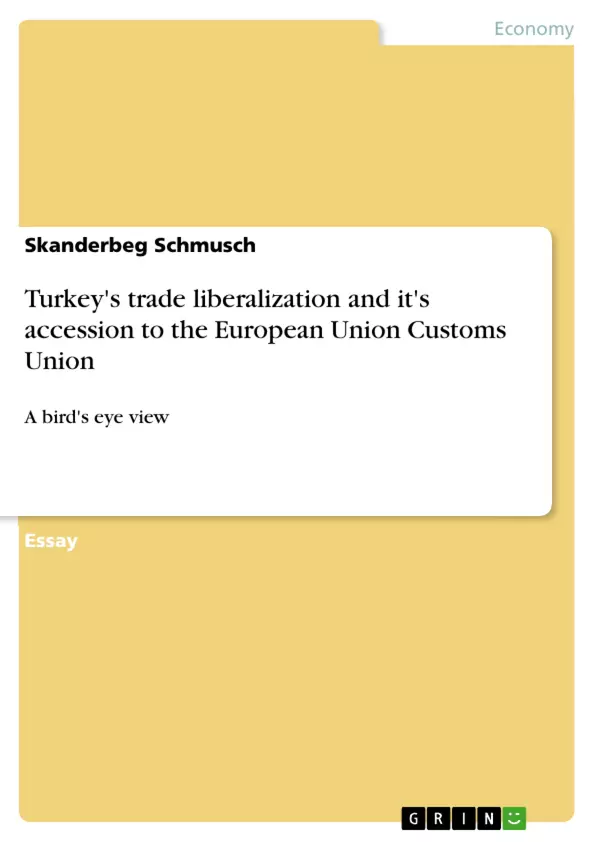People living in Turkey might have very well experienced it, people, like the author, looking at Turkey as an independant observer, might not know it too much. Since it's foundation in 1923, Turkey witnessed turbulent times almost thoroughgoing the 20th Century. Political as well as economical wise. Economically the climax was reached when Turkey felt into international insolvency in 1978. From then on, although attempts were made in earlier years too, large reforms were introduced. In this paper we will look at the Turkey's trade policy before and after the liberalization reforms of the 1980's.
Trade liberalization mostly implies less intervention by the government in the
traded goods sectors. But whether a less interventionist trade regime results in a less distorted, more open and outward oriented economy will depend on the characteristics of the pre- and post-reform trade and exchange rate regimes. This paper aims to present a general survey about Turkish trade policy: a bird's eye view. The author therefore abstains from generating a model and test the impact of the reforms on one single industry. Instead, such regression results are rather resorted to other studies, in order to generate an appropriate picture of the trade liberalization as a
whole without getting stucked into detail too much on the one hand, and without
staying out of detail too much on the other hand. The rst section outlines the
economical background of Turkey from the pre-1980-reform period at rst and con-
tinues with a presentation of the reforms imposed from 1980 onwards. It draws a
historical picture as well as it points out the main impacts on the export and import pattern of Turkey's foreign trade. The following section deals with Turkey's accession of the Customs Union of the European Union in 1996. There is economical and politacal weight ascribed to the accesion as it is seen to be a major step towards a full membership of the European Union for Turkey. After outdrawing the historical backgrounds of the accesion, we will look at its impact on trade for several sectors, mainly by examining a study done by De Santis in 2001. Another section shows some empirical observations on trade indicators and their change in respect to the liberalization reforms.
Inhaltsverzeichnis (Table of Contents)
- The Issue
- Trade Liberalization in Turkey
- The Pre-1980 Period
- The 1980's Reforms and their Impact on Turkey's Foreign Trade
- Turkey and the European Union Customs Union
- Trade Creation or Trade Diversion?
- Empirical Observations of Trade Liberalization in Turkey
- Protection Rates
- Import Elasticities
- Conclusion
Zielsetzung und Themenschwerpunkte (Objectives and Key Themes)
This paper provides a broad overview of Turkey's trade policy before and after the liberalization reforms of the 1980s. It aims to present a general survey of Turkish trade policy without delving into specific industries or generating a model to test the impact of reforms. The paper will primarily focus on the economic background of Turkey from the pre-1980 reform period, the implementation and impact of the 1980s reforms, and the implications of Turkey's accession to the European Union Customs Union in 1996.- Turkey's trade policy before and after the 1980s liberalization reforms
- The impact of the 1980s reforms on Turkish trade patterns
- The economic and political significance of Turkey's accession to the European Union Customs Union
- Empirical observations on trade indicators and their changes in relation to the liberalization reforms
Zusammenfassung der Kapitel (Chapter Summaries)
The Issue
This chapter introduces the context of Turkey's economic history, highlighting the country's turbulent 20th century and the economic difficulties that led to international insolvency in 1978. It also outlines the focus of the paper, which is to examine Turkey's trade policy before and after the liberalization reforms of the 1980s.Trade Liberalization in Turkey
This chapter delves into the evolution of Turkey's trade policy, focusing on the pre-1980 period characterized by interventionist and protectionist measures. It discusses the consequences of these policies, including economic disruptions and the adoption of an import substitution development strategy. The chapter also analyzes the reforms implemented in the 1980s, emphasizing the shift towards an export-led growth path and the significant impact on the composition of Gross Domestic Product.Turkey and the European Union Customs Union
This chapter explores the significance of Turkey's accession to the European Union Customs Union in 1996, emphasizing its economic and political weight as a step towards full EU membership. It also analyzes the impact of the Customs Union on trade for various sectors, drawing on research conducted by De Santis in 2001.Empirical Observations of Trade Liberalization in Turkey
This chapter provides empirical observations on trade indicators and their changes in relation to the liberalization reforms. It examines protection rates and import elasticities, offering insights into the effectiveness of the trade reforms.Schlüsselwörter (Keywords)
This paper delves into Turkey's trade liberalization, analyzing its economic policies, particularly the reforms implemented in the 1980s and the impact of the European Union Customs Union. Key themes include import substitution industrialization, export-led growth, trade creation and diversion, protection rates, and import elasticities.- Citation du texte
- Skanderbeg Schmusch (Auteur), 2008, Turkey's trade liberalization and it's accession to the European Union Customs Union, Munich, GRIN Verlag, https://www.grin.com/document/116113



